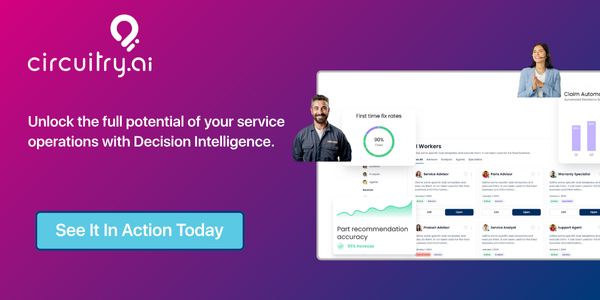At Circuitry.ai, we’re always looking for ways to make your service operations simpler and more effective while increasing your team’s capacity.
In our latest release, we introduced several exciting features designed to help you solve challenges faster, reduce effort, and get better results across your warranty, service, and parts operations.
From automating image analysis to giving you greater insights into claim trends, every feature is focused on helping you save time and make smarter decisions.
Check out our most exciting new features below:
Warranty Decision Intelligence
Keeping warranty costs under control means reducing claim errors and manual tasks, catching fraud, and identifying high-failure parts before they impact profitability.
Warranty Decision Intelligence works alongside your existing systems to deliver faster, more consistent warranty decisions powered by your warranty data. Warranty Decision Intelligence includes a suite of AI-powered Agents, Analysts, and Advisors.
Agents speed up repetitive tasks. Analysts detect risks early. Advisors bring real-time answers to your team and customers. Together, they create a continuous flow from intake to analysis to decision.
Warranty AI Agents
Manual claim review is slow and inconsistent. Agents use agentic AI to automate repetitive tasks like claim intake, image analysis, and routine processing steps.
For example, you can automate scoring with our Claim Score Agent. It automatically evaluates each claim using a weighted scoring model trained on your historical data. It considers certain factors to assign a risk score. Low-risk claims can move faster, while high-risk ones are flagged for review—helping your team make better, more consistent decisions.
The 3-C's Checker Agent reviews the Complaint, Cause, and Correction content in each claim. It evaluates clarity, completeness, and relevance, and flags vague or missing entries that could delay processing. This improves the quality of incoming claims and helps teams make faster, more confident adjustments.
You can also automate payments with our Payment Processing Agent, which reduces the back-and-forth between warranty and payment teams by automatically comparing submitted invoices to system records. It highlights mismatches, explains the differences, and shows a match percentage—giving teams the confidence to approve or reject with clarity. This speeds up processing and creates a smoother experience for dealers and customers.
Warranty AI Analysts
Warranty teams often rely on lagging indicators, like quarterly reports or rising costs, to catch recurring failures. But by the time those signals appear, it’s usually too late to prevent impact.
Analysts use predictive analytics to spot risks before they become problems. By connecting inspection reports, repair histories, and TSBs, Analysts surface patterns that signal potential part failures, recurring defects, or rising claim costs. This gives your team time to act, whether that means flagging dealers, updating repair guidance, or adjusting coverage policies.
Take our Failure Analyst, for example. Instead of waiting for quarterly reports, your team can ask the Analyst, “What’s driving breakdowns under 500 hours?” and instantly see defect patterns, affected parts, and likely root causes. It’s a faster way to catch issues, prioritize fixes, and make smarter decisions without digging through static dashboards.
Failure Analyst is just one example. Analysts can be configured to uncover whatever patterns matter most to your team.
Warranty AI Advisors
Warranty teams and customers both waste time searching for answers. Advisors use the power of LLMs to act as real-time knowledge experts, surfacing warranty policies, coverage rules, and historical claims information instantly. Advisors help teams make faster, more accurate decisions and gives customers clear answers to their warranty questions.
For example, in self-service, customers can ask questions like “Is my part still under warranty?” or “What’s the coverage period for emissions?” and get an answer instantly, without waiting on hold for support or submitting a ticket. The Advisor pulls directly from warranty policies and claim data to reduce inbound call volume and improve the customer experience.
Internally, claim teams can use Advisors to avoid digging through documents or pinging coworkers. A user might ask “Was this VIN denied last time?” or “What’s the rule for powertrain failures in year 3?” and get fast, accurate guidance, backed by warranty logic and historical claim data.
Image analysis
Warranty claims rely on submitted images for proof, but not all images can be trusted and manually checking every image is time-consuming and easy to get wrong.
AI-powered image checks take care of this process instantly. AI detects duplicate images and checks for AI-generated images to confirm authenticity. It also scans the web to see if a similar image exists elsewhere and extracts metadata like camera details and geolocation to verify its source.
Now, claim teams can trust that submitted images are real, unique, and relevant, eliminating fraud risks, speeding up processing, and ensuring accurate claim decisioning every time.
Intelligent routing
Your team shouldn’t have to think about which AI to use or how to route a question. With intelligent routing, they don’t have to.
Now, users can ask any question without needing to switch Advisors. The AI understands what they’re asking, identifies the right Advisor for the job, and delivers the answer in the same conversation.
Say someone’s interacting with a Parts Advisor but asks a warranty question. The system automatically routes that question to your Warranty Advisor, gets the answer, and returns it to the user. No tabs or no switching, just one unified interface that gives users the answers they need across warranty, parts, or service.
For teams that want to guide the experience more directly, users can use @mentions in the chat interface to select an Advisor to interact with.
And it doesn’t stop with answers. When a user’s request calls for action, like pulling invoice data or providing a claim score for a claim, the Advisor can also route the task to the right Agent automatically; no extra steps required.
Ready to try them out? Log in to your account now.
Don't have an account? Schedule a custom demo today to see the new features in action.
